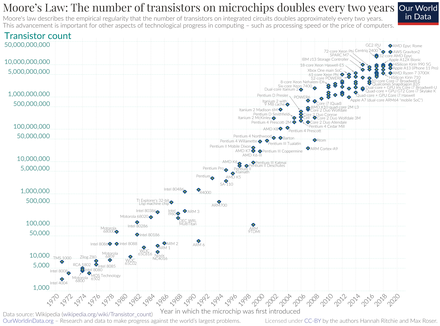
Back Moore se wet Afrikaans قانون مور Arabic Llei de Moore AST Mur qanunu Azerbaijani Закон на Мур Bulgarian মুরের সূত্র Bengali/Bangla Mooreov zakon BS Llei de Moore Catalan Moorův zákon Czech Moores lov Danish

| Semiconductor device fabrication |
|---|
 |
|
MOSFET scaling (process nodes) |
| Futures studies |
|---|
| Concepts |
| Techniques |
| Technology assessment and forecasting |
| Related topics |
Moore's law is the observation that the number of transistors in an integrated circuit (IC) doubles about every two years. Moore's law is an observation and projection of a historical trend. Rather than a law of physics, it is an empirical relationship. It is an experience-curve law, a type of law quantifying efficiency gains from experience in production.
The observation is named after Gordon Moore, the co-founder of Fairchild Semiconductor and Intel and former CEO of the latter, who in 1965 noted that the number of components per integrated circuit had been doubling every year,[a] and projected this rate of growth would continue for at least another decade. In 1975, looking forward to the next decade, he revised the forecast to doubling every two years, a compound annual growth rate (CAGR) of 41%. Moore's empirical evidence did not directly imply that the historical trend would continue, nevertheless his prediction has held since 1975 and has since become known as a "law".
Moore's prediction has been used in the semiconductor industry to guide long-term planning and to set targets for research and development, thus functioning to some extent as a self-fulfilling prophecy. Advancements in digital electronics, such as the reduction in quality-adjusted microprocessor prices, the increase in memory capacity (RAM and flash), the improvement of sensors, and even the number and size of pixels in digital cameras, are strongly linked to Moore's law. These ongoing changes in digital electronics have been a driving force of technological and social change, productivity, and economic growth.
Industry experts have not reached a consensus on exactly when Moore's law will cease to apply. Microprocessor architects report that semiconductor advancement has slowed industry-wide since around 2010, slightly below the pace predicted by Moore's law. In September 2022, Nvidia CEO Jensen Huang considered Moore's law dead,[2] while Intel CEO Pat Gelsinger was of the opposite view.[3]
Cite error: There are <ref group=lower-alpha> tags or {{efn}} templates on this page, but the references will not show without a {{reflist|group=lower-alpha}} template or {{notelist}} template (see the help page).